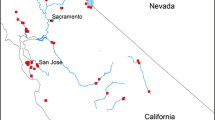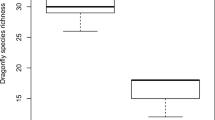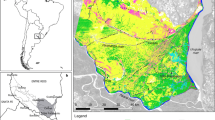Abstract
Natal habitat use by dragonflies was assessed on an urban to rural land-use gradient at a set of 21 wetlands, during two emergence seasons (2004, 2005). The wetlands were characterized for urbanization level by using the first factor from a principal components analysis combining chloride concentration in the wetland and percent forest in the surrounding buffer zone. Measurements of species diversity and its components (species richness and evenness) were analyzed and compared along the urbanization gradient, as were distributions of individual species. Dragonfly diversity, species richness, and evenness did not change along the urbanization gradient, so urban wetlands served as natal habitat for numerous dragonfly species. However, several individual species displayed strong relationships to the degree of urbanization, and most were more commonly found at urban sites and at sites with fish. In contrast, relatively rare species were generally found at the rural end of the gradient. These results suggest that urban wetlands can play important roles as dragonfly habitat and in dragonfly conservation efforts, but that conservation of rural wetlands is also important for some dragonfly species.




Similar content being viewed by others
References
Aliberti Lubertazzi MA (2009) Natal habitat use by dragonflies along landscape gradients in Rhode Island. Dissertation, University of Rhode Island, Kingston, RI
Aliberti Lubertazzi MA, Ginsberg HS (2009) Persistence of dragonfly exuviae on vegetation and rock substrates. Northeast Nat 16:141–147
Anderson JR, Hardy EE, Roach JT, Witmer RE (1976) A land use and land cover classification system for use with remote sensor data. Geological Survey Professional Paper 964. A revision of the land use classification system as presented in U.S. Geological Survey Circular 671. U. S. Dept. of the Interior, United States Government Printing Office, Washington, D.C
Bell HL (1971) Effect of low pH on the survival and emergence of aquatic insects. Water Res 5:313–319
Bendell BE, McNicol DK (1987) Fish predation, lake acidity and the composition of aquatic insect assemblages. Hydrobiologia 150:193–202
Biber E (2002) Habitat analysis of a rare dragonfly (Williamsonia lintneri) in Rhode Island. Northeast Nat 9(341):352
Blair RB (1999) Birds and butterflies along an urban gradient: surrogate taxa for assessing biodiversity? Ecol Appl 9:164–170
Blair RB (2004) The effects of urban sprawl on birds at multiple levels of biological organization. Ecol Soc 9:2
Blair RB, Launer AE (1997) Butterfly diversity and human land use: species assemblages along an urban gradient. Biol Conserv 80:113–125
Blois-Heulin C, Crowley PH, Arrington M, Johnson DM (1990) Direct and indirect effects of predators on the dominant invertebrates of two freshwater littoral communities. Oecologia 84:295–306
Bock CE, Jones ZF, Bock JH (2008) The oasis effect: response of birds to exurban development in a southwestern savanna. Ecol Appl 18:1093–1106
Booth DB, Hartley D, Jackson R (2002) Forest cover, impervious-surface area, and the mitigation of stormwater impacts. J Am Water Resour Assoc 38:835–845
Booth DB, Karr JR, Schauman S, Konrad CP, Morley SA, Larson MG, Burges SJ (2004) Reviving urban streams: land use, hydrology, biology, and human behavior. J Am Water Resour Assoc 40:1351–1364
Bright E, O’Brien MF (1999) Odonata larvae of Michigan: keys for, and notes on, the dragon- and damselfly larvae found in the State of Michigan. UMMZ-Insect Division. URL: http://insects.ummz.lsa.umich.edu/MICHODO/test/home.htm
Buskirk RE, Sherman KJ (1984) The influence of larval ecology on oviposition and mating strategies in dragonflies. Fla Entomol 68:39–51
Clark TE, Samways MJ (1997) Sampling arthropod diversity for urban ecological landscaping in a species-rich southern hemisphere botanic garden. J Insect Conserv 1:221–234
Clark PJ, Reed JM, Chew FS (2007) Effects of urbanization on butterfly species richness, guild structure, and rarity. Urban Ecosyst 10:321–337
Clesceri LS, Greenberg AE, Eaton AD (eds) (1998) Standard methods for the examination of water and wastewater, 20th edn. American Public Health Association, American Water Works Association and Water Environment Federation, Baltimore
Connell JH (1978) Diversity in tropical rain forests and coral reefs. Science 199:1302–1310
Conrad KF, Willson KH, Harvey IF, Thomas CJ, Sherratt TN (1999) Dispersal characteristics of seven odonate species in an agricultural landscape. Ecography 22:524–531
Corbet PS (1993) Are Odonata useful as bioindicators? Libellula 12:91–102
Creveling E (2003) An investigation of lentic Odonata assemblages and habitat associations in New York City. M.Sc. Thesis in Environmental Conservation, University of Greenwich, London, UK
D’Amico F, Darblade S, Avignon S, Blanc-Manel S, Ormerod SJ (2004) Odonates as indicators of shallow lake restoration by liming: comparing adult and larval responses. Restor Ecol 12:439–446
Denys C, Holger S (1998) Insect communities on experimental mugwort (Artemisia vulgaris L.) plots along an urban gradient. Oecologia 113:269–277
Ehrenfeld JG (2000) Evaluating wetlands within an urban context. Ecol Eng 15(253):265
Environmental Canada (2001) Canada Environmental Protection Act, 1999—Priority substances list assessment report: road salts. Health Canada, Ottawa
Eriksson MOG, Henrikson L, Nilsson B-I, Nyman G, Oscarson HG, Stenson AE (1980) Predator-prey relations important for the biotic changes in acidified lakes. Ambio 9:248–249
Faeth SH, Warren PS, Shochat E, Marussich WA (2005) Trophic dynamics in urban communities. Bioscience 55:399–407
Fischer S, Marinone MC, Fontanarrosa MS, Nieves M, Schweigmann N (2000) Urban rain pools: seasonal dynamics and entomofauna in a park of Buenos Aires. Hydrobiologia 441:45–53
Foote AL, Rice Hornung CL (2005) Odonates as biological indicators of grazing effects on Canadian prairie wetlands. Ecol Entomol 30:273–283
Fortin M, Legendre P (1989) Spatial autocorrelation and sampling design in plant ecology. Plant Ecol 83:209–222
Gibbs JP, Stanton EJ (2001) Habitat fragmentation and arthropod community change: carrion beetles, phoretic mites, and flies. Ecol Appl 11:79–85
Hawking JH, New TR (2003) Interpreting dragonfly diversity to aid in conservation assessment: lessons from the Odonata assemblage at Middle Creek, north-eastern Victoria, Australia. J Insect Conserv 6:171–178
Hudson J, Berrill M (1986) Tolerance of low pH exposure by the eggs of Odonata (dragonflies and damselflies). Hydrobiologia 140:21–25
Johansson F, Brodin T (2003) Effects of fish predators and abiotic factors on dragonfly community structure. J Freshw Ecol 18:415–423
Johansson F, Englund G, Brodin T, Gardfjell H (2006) Species abundance models and patterns in dragonfly communities: effects of fish predators. Oikos 114:27–36
Johnson DM, Crowley PH (1980) Odonate “hide and seek”: habitat-specific rules? In: Kerfoot WC (ed) ASLO special symposium: evolution and ecology of Zooplankton communities. University Press of New England, Hanover, pp 569–579
Johnson DM, Soluk DA, Debinski D (2001) The endangered Hine’s emerald dragonfly. In: Wings: essays on invertebrate conservation. Xerces Society, Portland, OR, pp. 17–21
Kaushal SS, Groffman PM, Likens GE, Belt KT, Stack WP, Kelly VR, Band LE, Fisher GT (2005) Increased salinization of fresh water in the northeastern United States. Proc Natl Acad Sci USA 102:13517–13520
Koh LP, Sodhi NS (2004) Importance of reserves, fragments, and parks for butterfly conservation in a tropical urban landscape. Ecol Appl 14:1695–1708
Magura T, Tothmeresz B, Molnar T (2004) Changes in carabid beetle assemblages along an urbanisation gradient in the city of Debrecen, Hungary. Landscape Ecol 19:747–759
Marchand MN, Litvaitis JA (2004) Effects of habitat features and landscape composition on the population structure of a common aquatic turtle in a region undergoing rapid development. Conserv Biol 18:758–767
Matteson KC, Ascher JS, Langellotto GA (2008) Bee richness and abundance in New York City urban gardens. Ann Entomol Soc Am 101:140–150
McFrederick QS, LeBuhn G (2006) Are urban parks refuges for bumble bees Bombus spp. (Hymenoptera: Apidae)? Biol Conserv 129:372–382
McIntyre NE (2000) Ecology of urban arthropods: a review and a call to action. Ann Entomol Soc Am 93:825–835
McIntyre NE, Hostetler ME (2001) Effects of urban land use on pollinator (Hymenoptera: Apoidea) communities in a desert metropolis. Basic Appl Ecol 2:209–218
McIntyre NE, Rango J, Fagan WF, Faeth SH (2001) Ground arthropod community structure in a heterogeneous urban environment. Landsc Urban Plan 52:257–274
McKinney ML (2006) Urbanization as a major cause of biotic homogenization. Biol Conserv 127:247–260
McPeek MA (1990a) Determination of species composition in the Enallagma damselfly assemblages of permanent lakes. Ecology 71:83–98
McPeek MA (1990b) Behavioral differences between Enallagma species (Odonata) influencing differential vulnerability to predators. Ecology 71:1714–1726
Miller JN, Brooks RP, Croonquist MJ (1997) Effects of landscape patterns on biotic communities. Landscape Ecol 12:137–153
Moore NW (1991) The development of dragonfly communities and the consequences of territorial behaviour: a 27 year study on small ponds at Woodwalton Fen, Cambridgeshire, United Kingdom. Odonatologica 20:203–231
Morin PJ (1984a) The impact of fish exclusion on the abundance and species composition of larval odonates: results of short-term experiments in a North Carolina farm pond. Ecology 65:53–60
Morin PJ (1984b) Odonate guild composition: experiments with colonization history and fish predation. Ecology 65:1866–1873
Needham JG, Westfall JMJ, May ML (2000) Dragonflies of North America, revisedth edn. Scientific, Gainesville
Nilsson AN, Svensson BW (1995) Assemblages of dytiscid predators and culicid prey in relation to environmental factors in natural and clear-cut boreal swamp forest pools. Hydrobiologia 308:183–196
Ormerod SJ, Weatherley NS, Merrett WJ (1990) The influence of conifer plantations on the distribution of the Golden Ringed Dragonfly Cordulegaster boltoni (Odonata) in Upland Wales. Biol Conserv 53:241–251
Paul MJ, Meyer JL (2001) Streams in the urban landscape. Annu Rev Ecol Syst 32:333–365
Pierce CL, Crowley PH, Johnson DM (1985) Behavior and ecological interactions of larval Odonata. Ecology 66:1504–1512
Price SJ, Marks DR, Howe RW, Hanowski JM, Niemi GJ (2004) The importance of spatial scale for conservation and assessment of anuran populations in coastal wetlands of the western Great Lakes, USA. Landscape Ecol 20:441–454
Pulliam HR (1988) Sources, sinks, and population regulation. Am Nat 132:652–661
RIGIS (2002) Census—Pop2000—US 2000 census population & housing. Rhode Island Geographic Information System (RIGIS) Data Distribution System (ed) Environmental Data Center, University of Rhode Island, Kingston, RI. URL: http://www.edc.uri.edu/rigis
RIGIS (2005) 1995 Land use for Rhode Island. Rhode Island Geographic Information System (RIGIS) Data Distribution System (ed) Environmental Data Center, University of Rhode Island, Kingston, RI. URL: http://www.edc.uri.edu/rigis
Rubbo MJ, Kiesecker JM (2005) Amphibian breeding distribution in an urbanized landscape. Conserv Biol 19:504–511
Samways MJ, Steytler NS (1996) Dragonfly (Odonata) distribution patterns in urban and forest landscapes, and recommendations for riparian management. Biol Conserv 78:279–288
Shannon CE, Weaver W (1949) The mathematical theory of communication. University of Illinois Press, Urbana
Shapiro AM (2002) The Californian urban butterfly fauna is dependent on alien plants. Divers Distrib 8:31–40
Shochat E, Stefanov WL, Whitehouse MEA, Faeth SH (2004) Urbanization and spider diversity: influences of human modification of habitat structure and productivity. Ecol Appl 14:268–280
Simberloff D (1997) The biology of invasions. In: Simberloff D, Schmitz DC, Brown TC (eds) Strangers in paradise. Island, Washington, D.C., pp 3–19
Simpson EH (1949) Measurement of diversity. Nature 163:688
Soltesz KL (1996) Identification keys to northeastern Anisoptera larvae. Center for Conservation and Biodiversity, University of Connecticut
Southwood TRE, Henderson PA (2000) Ecological methods, 3rd edn. Blackwell, Malden
terBraak CJF, Smilauer P (1997–1999) Canoco for Windows, version 4.02. Centre for Biometry Wageningen, CPRO-DLO, Wageningen, The Netherlands
Theobald DM (2004) Placing exurban land-use change in a human-modification framework. Front Ecol Environ 2:139–144
Thompson B, McLachlan S (2007) The effects of urbanization on ant communities and myrmecochory in Manitoba, Canada. Urban Ecosyst 10:43–52
URI Watershed Watch (2006) 2006 Parameter data: chloride data; lakes, ponds and reservoirs; listed alphabetically. University of Rhode Island, Kingston
Walker EM (1958) The Odonata of Canada and Alaska. Part II: the Anisoptera—four families. University of Toronto Press, Toronto
Walker EM, Corbet PS (1975) The Odonata of Canada and Alaska. Part III: the Anisoptera—three families. University of Toronto Press, Toronto
Winfree R, Griswold T, Kremen C (2007) Effect of human disturbance on bee communities in a forested ecosystem. Conserv Biol 21:213–223
Acknowledgments
We thank Ryan Abney and Megan Priede for assistance with field work, and the URI Coastal Fellows program for funding their work. Art Gold, Kelly Addy, and Linda Green provided guidance on water quality analyses. Peter August performed the spatial autocorrelation analysis. Mary-Jane James-Pirri assisted with formatting Fig. 1. We thank Peter August, Eric Biber, Sam Droege, Patrick Logan, Nancy McIntyre and two anonymous reviewers for constructive comments on early drafts of the manuscript.
Author information
Authors and Affiliations
Corresponding author
Rights and permissions
About this article
Cite this article
Aliberti Lubertazzi, M.A., Ginsberg, H.S. Emerging dragonfly diversity at small Rhode Island (U.S.A.) wetlands along an urbanization gradient. Urban Ecosyst 13, 517–533 (2010). https://doi.org/10.1007/s11252-010-0133-8
Published:
Issue Date:
DOI: https://doi.org/10.1007/s11252-010-0133-8




